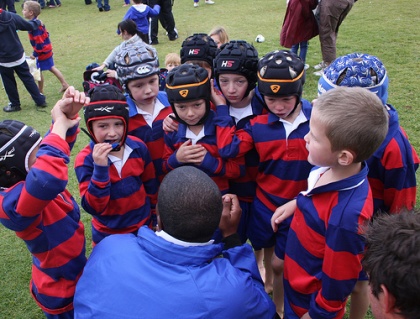
Photo from Rugby Coaching Blog
From September it is rumoured that the county that my club operates in will be added to the “Shaping the Game” pilot project that the RFU have been running in three counties over the last year (Durham, Hampshire and Warwickshire), which is based on research commissioned by the RFU in 2007, by Exeter University. The full recommendations are available for download here. The idea behind this pilot is to better manage the transition between TAG rugby at under 8 and contact rugby from under 9. It also involves changes to the Under 7 and Under 8’s game and, ultimately, if the overall pilot is rolled out, it will change all aspects of mini rugby. The RFU states that “the aim being to develop an improvement in young players’ skills and higher levels of their retention into the adult game.”
The bit I would like to discuss is the under 9 changes. The key changes are that there will be no scrum or line-out, and no rucks or mauls. The “tackle” is defined as any attempt at contact from the arm-pits down, and after bringing the ball carrier to ground, a tackler can no longer compete for the ball. There is also no ripping the ball out of contact.
In my last blog, “U9 Mini Rugby Frustration” I wrote about the fact that (in my opinion) tackle-shields (and the timescale imposed/coaching techniques) encourage young players to run into contact. I mentioned that there needed to be a balance. Rugby is a contact sport and many players take up the game so they too can play the game they watch on television.
Having coached under 7s and under 8s, I could see that many young players are keen to start playing ‘proper’ rugby. This phrase has driven a lot of discussion in forums about this pilot. Those in favour of the changes point out that contact is only a part of the game, but I have examples of players that stop playing at the end of the under 7 season because they do not want to play TAG for another season. In the worst case example, the player moved to another club that allowed him to play up a year.
My view, and it remains only my view, is that the basic structure of the pilot is flawed. Data on the impact of the initial pilot which was set as a three-year plan cannot have been captured after year 1. Of course, there are many statistics which show more tries being scored and more passes being made at under 7 and under 8 levels. This is where games are 4-a-side, but statistics still do not show whether all players scored more tries and were passed to. It just shows more of the activity.
The critical impact of this proposal cannot be measured yet – that is the retention of players. How do we know that those moving from under 8s to under 9s will come back to a game that differs from the sport they thought they were playing? One of the reasons for what is a watering down of the contact aspect of the game is that it was suggested that this puts some players off. What about those players who want that aspect of the game? Surely this is the beauty of our game. I read a blog from a coach I really respect recently, which said that this sort of approach is the same as taking your child to boxing because they wanted to play that sport, but not allowing them to punch anything.
The trick is to coach technique in all aspects of the game: evasion, contact, ball retention and recovery, passing, catching, etc., and work with the children to raise their skill levels and individual confidence in all the areas of the game. If we make it just an evasion game, do we not run the risk of alienating those players who aren’t fast and elusive? Isn’t it a coaching skill-set which needs to be improved rather than delayed?
By: Spike, a Level 2 coaching the Colts and U15s at a local club in Norfolk who has been coaching for over 14 years.








 When most people hear the word “Peloton” they think of an expensive black bike with shiny red buttons and that controversial commercial where the husband gifted his wife a Peloton for Christmas.
When most people hear the word “Peloton” they think of an expensive black bike with shiny red buttons and that controversial commercial where the husband gifted his wife a Peloton for Christmas. If the app interests you, Peloton is currently offering a 30 day FREE TRIAL, so why not give it a try? Check it out
If the app interests you, Peloton is currently offering a 30 day FREE TRIAL, so why not give it a try? Check it out 

 This article would not be complete, however, if we did not acknowledge some of the delivery issues that have been plaguing Peloton over the last year. Most of the delivery issues seem to affect U.S. deliveries, however, the UK deliveries have been affected as well.
This article would not be complete, however, if we did not acknowledge some of the delivery issues that have been plaguing Peloton over the last year. Most of the delivery issues seem to affect U.S. deliveries, however, the UK deliveries have been affected as well.








1 Comment to Changes to Minis Rugby